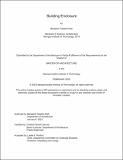Building Enclosure
Author(s)
Tasistro-Hart, Benjamin
DownloadThesis PDF (22.75Mb)
Advisor
Alonso, Cristina Parreño
Terms of use
Metadata
Show full item recordAbstract
Enclosure is usually understood by architects as a material system that creates a distinct thermodynamic atmosphere. The past century of Modernism reified the façade as the dominant architectural element of enclosure. In the Anthropocene, an expanded understanding of enclosure redraws the boundary of shelter beyond the façade to include the territories of land used to produce architecture.
This thesis situates itself in the forests of the Southeastern United States. These predominantly pine forests are usually overlooked in favor of the iconic National Forests of the West Coast. Almost entirely privately-owned, the forests in the Southeast are intensely managed caught between being part nature preserve and part timber stand. Nearly two-thirds of timber construction material in the nation comes from these forests which more recently has attracted the interest of architects as the forms of engineered timber but has for decades lurked in the walls of vernacular dwellings.
Since the early twentieth century, the average dwelling has over doubled in built area. Larger, more numerous rooms require more material and lead to a reciprocal increase the intensity of commercial timber operations. Building enclosures that can accommodate the growing populations of the Southeast will need to reframe the static views of dwelling and timber stand as reciprocal sites embedded with cycles of material generation. This project proposes three interventions each located within periods of material abundance and scarcity found in timber dwelling cycle. Each intervention engages the dweller with the past, present, and future world of the Southeastern forest.
Date issued
2023-02Department
Massachusetts Institute of Technology. Department of ArchitecturePublisher
Massachusetts Institute of Technology